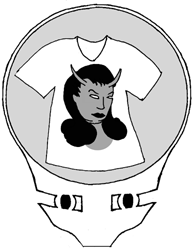![[MetroActive Features]](/features/gifs/feat468.gif)
[ Features Index | Santa Cruz Week | MetroActive Central | Archives ]
Semiotic Whatever
By Annalee Newitz
I'VE BEEN USING ICONS to navigate my online universe for so long that it's become second nature for me to think of everything I see as little symbols that stand in for something else. One bleary night, as I left work, I saw a sign with a picture of a house on it and found my fingers twitching reflexively, trying to click on it so I could go home. Sometimes, I'll find myself puzzling out the possible computer-related meaning of some random object, like a fire hydrant. "Does that icon have to do with firewalls?" I'll ask myself, "Or maybe cleaning things up, like with water?"
However, I'm not usually in a state of near-hallucinatory exhaustion, so I don't generally think an ambulance screaming down the street is rushing to bring "first aid" to a crashed disk. Instead, I'll catch myself abstractedly musing about how Everything Seems Symbolic. This, I find, is particularly true when I encounter T-shirts.
T-shirts with logos on them are supposed to link their user/wearer to some larger class of objects or processes. Jesse wears OpenBSD T-shirts because he belongs to a class of people who value open source software and network security. And I wear Star Trek T-shirts because I'm ... well, I leave it to you to make the obvious joke about my dorkiness here.
But my icon-saturated brain decodes hidden meanings in T-shirts, too. The other day I noticed a lusciously chubby young woman wearing a T-shirt with the Devilettes logo on it. The Devilettes are a San Francisco troupe of retro go-go dancers who do semi-ironic synchronized dances in tiny 1960s-style outfits that clash pleasingly with their very millennial tattoos, dyed hair and piercings. Most importantly, several of the Devilettes are sexy without being skinny.
As writers like Justine Sharrock have pointed out, it's hard for a girl to be chubby and feel sexy, even in allegedly liberated cities like Santa Cruz. Lots of people still think women must be tiny to be foxy, and that's why I've always appreciated the Devilettes for their symbolic meaning. They--like that cute gal wearing their T-shirt--demonstrate that chubby equals hot.
There's nothing more heavenly than watching a Devilette dance and jiggle. So when I walk past curvaceous girls wearing Devilette T-shirts, we share a moment of iconic identification, knowing that we belong to a class of people who flaunt our extra-juicy bodies without shame.
Practically every college-educated person who took a liberal arts class during the past 15 years has been exposed to semiotics, the study of signs in everyday life. Indeed, to the semiotician, a Pilot Dr. Grip pen possesses as many symbolic meanings as a Devilettes T-shirt or a short story by some famous French writer.
Thanks to the web and, um, T-shirts, we live in a truly semiotic universe. Anyone who has worked with even the most primitive sort of computer "desktop" environment has entered a realm of signs where cartoon trashcans stand in for "delete" (already a pretty symbolic phrase) and pictures of folders represent directories (also, now that I think about it, an abstract idea). Basically, GUIs are all a tangled mess of symbols that refer to symbols that refer to concepts.
Think about it this way: If a picture of a piece of paper falling off a clipboard is a sign for "paste," what does paste stand for? "Paste" is hardly a concrete idea, especially when applied to chunks of data like text or images. Paste refers to what you do when you stick two things together with glue. So the clipboard icon refers to paste, which refers to glue, which is miraculously supposed to make us think about what would happen if we moved a piece of data from one location to another. I'm so used to thinking in long chains of symbols that this seems perfectly reasonable. And it seems equally reasonable to ascribe cultural meaning to logos on T-shirts, television commercials about the way Slim Jims behave in your stomach after you've eaten them, and even to the way some cute boy I've just asked out places smiley icons in his emails.
For those of us with the kinds of jobs that place us in the online realm, the symbolic order has clearly taken over our brains. And there's no way to escape the clutches of the symbolic once you're trapped in it. The symbolic writes you, not the other way around.
Copyright © Metro Publishing Inc. Maintained by Boulevards New Media.
![]()

Illustration by Jeremy Russell
Annalee Newitz, [email protected], is a surly media nerd who wears a metonymic chain.
From the March 21-28, 2001 issue of Metro Santa Cruz.